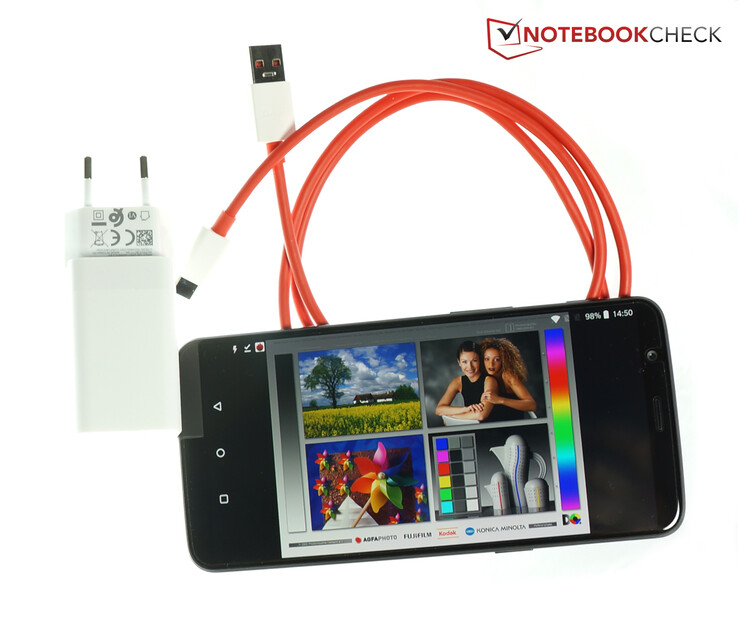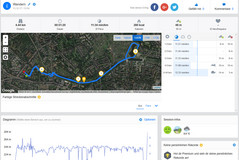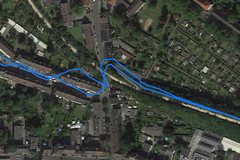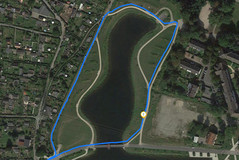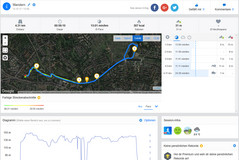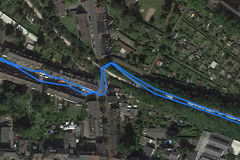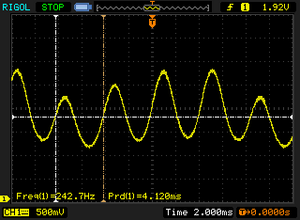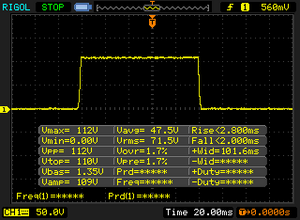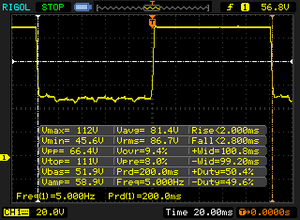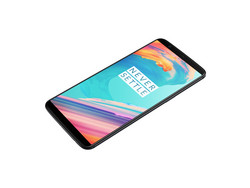Recensione breve dello smartphone OnePlus 5T
I nostri Top 10
» Top 10 Portatili Multimedia
» Top 10 Portatili Gaming
» Top 10 Portatili Gaming Leggeri
» Top 10 Portatili da Ufficio e Business economici
» Top 10 Portatili Premium da Ufficio/Business
» Top 10 Portatili sotto i 300 Euro
» Top 10 Portatili sotto i 500 Euro
» Top 10 dei Portatili Workstation
» Top 10 Subnotebooks
» Top 10 Ultrabooks
» Top 10 Convertibili
» Top 10 Tablets
» Top 10 Tablets Windows
» Top 10 Smartphones
Size Comparison
| Networking | |
| iperf3 transmit AX12 | |
| LG V30 | |
| Samsung Galaxy S8 Plus | |
| OnePlus 5T | |
| OnePlus 5 | |
| Sony Xperia XZ1 | |
| Asus ZenFone 4 ZE554KL | |
| Google Pixel 2 XL | |
| iperf3 receive AX12 | |
| LG V30 | |
| Sony Xperia XZ1 | |
| OnePlus 5T | |
| OnePlus 5 | |
| Samsung Galaxy S8 Plus | |
| Asus ZenFone 4 ZE554KL | |
| Google Pixel 2 XL | |
| |||||||||||||||||||||||||
Distribuzione della luminosità: 92 %
Al centro con la batteria: 425 cd/m²
Contrasto: ∞:1 (Nero: 0 cd/m²)
ΔE ColorChecker Calman: 2.1 | ∀{0.5-29.43 Ø4.78}
ΔE Greyscale Calman: 2.5 | ∀{0.09-98 Ø5}
Gamma: 2.32
CCT: 6455 K
| OnePlus 5T AMOLED, 2160x1080, 6" | Sony Xperia XZ1 IPS, 1920x1080, 5.2" | Asus ZenFone 4 ZE554KL IPS, 1920x1080, 5.5" | Google Pixel 2 XL P-OLED, 2880x1440, 6" | LG V30 OLED, 2880x1440, 6" | Samsung Galaxy S8 Plus Super AMOLED, 2960x1440, 6.2" | OnePlus 5 AMOLED, 1920x1080, 5.5" | |
|---|---|---|---|---|---|---|---|
| Screen | -23% | -47% | -16% | -61% | 20% | 6% | |
| Brightness middle (cd/m²) | 425 | 620 46% | 656 54% | 415 -2% | 432 2% | 560 32% | 426 0% |
| Brightness (cd/m²) | 423 | 610 44% | 634 50% | 420 -1% | 428 1% | 562 33% | 431 2% |
| Brightness Distribution (%) | 92 | 93 1% | 93 1% | 87 -5% | 87 -5% | 93 1% | 93 1% |
| Black Level * (cd/m²) | 0.79 | 0.4 | |||||
| Colorchecker dE 2000 * | 2.1 | 4.2 -100% | 5.3 -152% | 2.7 -29% | 4.18 -99% | 1.7 19% | 1.6 24% |
| Colorchecker dE 2000 max. * | 3.4 | 5.8 -71% | 7.8 -129% | 4.3 -26% | 8.53 -151% | 3.4 -0% | 4.1 -21% |
| Greyscale dE 2000 * | 2.5 | 3.9 -56% | 5.2 -108% | 3.3 -32% | 5.3 -112% | 1.6 36% | 1.7 32% |
| Gamma | 2.32 95% | 2.02 109% | 2.22 99% | 2.36 93% | 2.33 94% | 2.13 103% | 2.25 98% |
| CCT | 6455 101% | 7086 92% | 7905 82% | 6787 96% | 7487 87% | 6435 101% | 6329 103% |
| Contrast (:1) | 785 | 1640 | |||||
| Color Space (Percent of AdobeRGB 1998) (%) | 81.57 | ||||||
| Color Space (Percent of sRGB) (%) | 99.87 |
* ... Meglio usare valori piccoli
Sfarfallio dello schermo / PWM (Pulse-Width Modulation)
| flickering dello schermo / PWM rilevato | 242.7 Hz | ||
Il display sfarfalla a 242.7 Hz (Probabilmente a causa dell'uso di PWM) . La frequenza di 242.7 Hz è relativamente bassa, quindi gli utenti sensibili potrebbero notare il flickering ed accusare stanchezza agli occhi a questo livello di luminosità e a livelli inferiori. In confronto: 53 % di tutti i dispositivi testati non utilizza PWM per ridurre la luminosita' del display. Se è rilevato PWM, una media di 8111 (minimo: 5 - massimo: 343500) Hz è stata rilevata. | |||
Tempi di risposta del Display
| ↔ Tempi di risposta dal Nero al Bianco | ||
|---|---|---|
| 4.8 ms ... aumenta ↗ e diminuisce ↘ combinato | ↗ 2.8 ms Incremento | |
| ↘ 2 ms Calo | ||
| Lo schermo ha mostrato valori di risposta molto veloci nei nostri tests ed è molto adatto per i gaming veloce. In confronto, tutti i dispositivi di test variano da 0.1 (minimo) a 240 (massimo) ms. » 16 % di tutti i dispositivi è migliore. Questo significa che i tempi di risposta rilevati sono migliori rispettto alla media di tutti i dispositivi testati (20.2 ms). | ||
| ↔ Tempo di risposta dal 50% Grigio all'80% Grigio | ||
| 4.8 ms ... aumenta ↗ e diminuisce ↘ combinato | ↗ 2 ms Incremento | |
| ↘ 2.8 ms Calo | ||
| Lo schermo ha mostrato valori di risposta molto veloci nei nostri tests ed è molto adatto per i gaming veloce. In confronto, tutti i dispositivi di test variano da 0.165 (minimo) a 636 (massimo) ms. » 15 % di tutti i dispositivi è migliore. Questo significa che i tempi di risposta rilevati sono migliori rispettto alla media di tutti i dispositivi testati (31.6 ms). | ||
| AnTuTu v6 - Total Score (ordina per valore) | |
| OnePlus 5T | |
| Sony Xperia XZ1 | |
| Asus ZenFone 4 ZE554KL | |
| Google Pixel 2 XL | |
| LG V30 | |
| Samsung Galaxy S8 Plus | |
| OnePlus 5 | |
| Huawei Mate 10 Pro | |
| PCMark for Android | |
| Work performance score (ordina per valore) | |
| OnePlus 5T | |
| Sony Xperia XZ1 | |
| Asus ZenFone 4 ZE554KL | |
| Google Pixel 2 XL | |
| LG V30 | |
| Samsung Galaxy S8 Plus | |
| OnePlus 5 | |
| Huawei Mate 10 Pro | |
| Work 2.0 performance score (ordina per valore) | |
| OnePlus 5T | |
| Sony Xperia XZ1 | |
| Asus ZenFone 4 ZE554KL | |
| Google Pixel 2 XL | |
| LG V30 | |
| Samsung Galaxy S8 Plus | |
| OnePlus 5 | |
| Huawei Mate 10 Pro | |
| GFXBench (DX / GLBenchmark) 2.7 | |
| T-Rex Onscreen (ordina per valore) | |
| OnePlus 5T | |
| Sony Xperia XZ1 | |
| Asus ZenFone 4 ZE554KL | |
| Google Pixel 2 XL | |
| LG V30 | |
| Samsung Galaxy S8 Plus | |
| OnePlus 5 | |
| Huawei Mate 10 Pro | |
| 1920x1080 T-Rex Offscreen (ordina per valore) | |
| OnePlus 5T | |
| Sony Xperia XZ1 | |
| Asus ZenFone 4 ZE554KL | |
| Google Pixel 2 XL | |
| LG V30 | |
| Samsung Galaxy S8 Plus | |
| OnePlus 5 | |
| Huawei Mate 10 Pro | |
| GFXBench 3.0 | |
| on screen Manhattan Onscreen OGL (ordina per valore) | |
| OnePlus 5T | |
| Sony Xperia XZ1 | |
| Asus ZenFone 4 ZE554KL | |
| Google Pixel 2 XL | |
| LG V30 | |
| Samsung Galaxy S8 Plus | |
| OnePlus 5 | |
| Huawei Mate 10 Pro | |
| 1920x1080 1080p Manhattan Offscreen (ordina per valore) | |
| OnePlus 5T | |
| Sony Xperia XZ1 | |
| Asus ZenFone 4 ZE554KL | |
| Google Pixel 2 XL | |
| LG V30 | |
| Samsung Galaxy S8 Plus | |
| OnePlus 5 | |
| Huawei Mate 10 Pro | |
| GFXBench 3.1 | |
| on screen Manhattan ES 3.1 Onscreen (ordina per valore) | |
| OnePlus 5T | |
| Sony Xperia XZ1 | |
| Asus ZenFone 4 ZE554KL | |
| Google Pixel 2 XL | |
| LG V30 | |
| Samsung Galaxy S8 Plus | |
| OnePlus 5 | |
| Huawei Mate 10 Pro | |
| 1920x1080 Manhattan ES 3.1 Offscreen (ordina per valore) | |
| OnePlus 5T | |
| Sony Xperia XZ1 | |
| Asus ZenFone 4 ZE554KL | |
| Google Pixel 2 XL | |
| LG V30 | |
| Samsung Galaxy S8 Plus | |
| OnePlus 5 | |
| Huawei Mate 10 Pro | |
| JetStream 1.1 - Total Score | |
| OnePlus 5 (Chrome 59) | |
| OnePlus 5T (Chrome 63) | |
| Google Pixel 2 XL (Chrome 62) | |
| Samsung Galaxy S8 Plus (Samsung Browser 5.2) | |
| Sony Xperia XZ1 (Chrome 61) | |
| Huawei Mate 10 Pro (Chrome 61) | |
| LG V30 (Chrome 62) | |
| Asus ZenFone 4 ZE554KL (Chrome 62) | |
| Octane V2 - Total Score | |
| Samsung Galaxy S8 Plus (Samsung Browser 5.2) | |
| OnePlus 5T (Chrome 63) | |
| OnePlus 5 (Chrome 59) | |
| Google Pixel 2 XL (Chrome 62) | |
| LG V30 (Chrome 62) | |
| Huawei Mate 10 Pro (Chrome 61) | |
| Sony Xperia XZ1 (Chrome 61) | |
| Asus ZenFone 4 ZE554KL (Chrome 62) | |
| Mozilla Kraken 1.1 - Total | |
| Asus ZenFone 4 ZE554KL (Chrome 62) | |
| LG V30 (Chrome 62) | |
| Huawei Mate 10 Pro (Chrome 61) | |
| Google Pixel 2 XL (Chrome 62) | |
| Sony Xperia XZ1 (Chrome 61) | |
| OnePlus 5T (Chrome 63) | |
| OnePlus 5 (Chrome 59) | |
| Samsung Galaxy S8 Plus (Samsung Browser 5.2) | |
| WebXPRT 2015 - Overall | |
| Google Pixel 2 XL (Chrome 62) | |
| OnePlus 5T (Chrome 63) | |
| Sony Xperia XZ1 (Chrome 61) | |
| OnePlus 5 (Chrome 59) | |
| Huawei Mate 10 Pro (Chrome 61) | |
| Samsung Galaxy S8 Plus (Samsung Browser 5.2) | |
| LG V30 (Chrome 62) | |
| Asus ZenFone 4 ZE554KL (Chrome 62) | |
* ... Meglio usare valori piccoli
| OnePlus 5T | Sony Xperia XZ1 | Asus ZenFone 4 ZE554KL | Google Pixel 2 XL | LG V30 | Samsung Galaxy S8 Plus | OnePlus 5 | |
|---|---|---|---|---|---|---|---|
| AndroBench 3-5 | -4% | -43% | 5% | -25% | -6% | 1% | |
| Sequential Read 256KB (MB/s) | 699 | 679 -3% | 287.4 -59% | 760 9% | 669 -4% | 788 13% | 748 7% |
| Sequential Write 256KB (MB/s) | 203.4 | 204.4 0% | 205.3 1% | 195.3 -4% | 193.2 -5% | 194.2 -5% | 201.5 -1% |
| Random Read 4KB (MB/s) | 138.1 | 156.6 13% | 68.6 -50% | 170.6 24% | 78.2 -43% | 127.2 -8% | 141 2% |
| Random Write 4KB (MB/s) | 20 | 14.93 -25% | 7.59 -62% | 17.84 -11% | 10.21 -49% | 15.27 -24% | 19.3 -3% |
| Sequential Read 256KB SDCard (MB/s) | 65.5 ? | 86.9 ? | 62.8 | 71.1 ? | |||
| Sequential Write 256KB SDCard (MB/s) | 47.71 ? | 66.5 ? | 47.2 | 57.2 ? |
| Asphalt 8: Airborne | |||
| Settaggi | Valore | ||
| high | 30 fps | ||
| very low | 30 fps | ||
| Dead Trigger 2 | |||
| Settaggi | Valore | ||
| high | 60 fps | ||
(+) La temperatura massima sul lato superiore è di 36.1 °C / 97 F, rispetto alla media di 35.2 °C / 95 F, che varia da 21.9 a 247 °C per questa classe Smartphone.
(+) Il lato inferiore si riscalda fino ad un massimo di 33.7 °C / 93 F, rispetto alla media di 34 °C / 93 F
(+) In idle, la temperatura media del lato superiore è di 25.7 °C / 78 F, rispetto alla media deld ispositivo di 32.9 °C / 91 F.
OnePlus 5T analisi audio
(+) | gli altoparlanti sono relativamente potenti (86.3 dB)
Bassi 100 - 315 Hz
(-) | quasi nessun basso - in media 21.2% inferiori alla media
(±) | la linearità dei bassi è media (9.9% delta rispetto alla precedente frequenza)
Medi 400 - 2000 Hz
(+) | medi bilanciati - solo only 3% rispetto alla media
(+) | medi lineari (6% delta rispetto alla precedente frequenza)
Alti 2 - 16 kHz
(±) | alti elevati - circa 5.9% superiori alla media
(+) | alti lineari (3.8% delta rispetto alla precedente frequenza)
Nel complesso 100 - 16.000 Hz
(±) | la linearità complessiva del suono è media (18.4% di differenza rispetto alla media
Rispetto alla stessa classe
» 19% di tutti i dispositivi testati in questa classe è stato migliore, 9% simile, 72% peggiore
» Il migliore ha avuto un delta di 11%, medio di 35%, peggiore di 134%
Rispetto a tutti i dispositivi testati
» 40% di tutti i dispositivi testati in questa classe è stato migliore, 8% similare, 53% peggiore
» Il migliore ha avuto un delta di 4%, medio di 24%, peggiore di 134%
OnePlus 5 analisi audio
(+) | gli altoparlanti sono relativamente potenti (87.8 dB)
Bassi 100 - 315 Hz
(-) | quasi nessun basso - in media 30.9% inferiori alla media
(±) | la linearità dei bassi è media (9.4% delta rispetto alla precedente frequenza)
Medi 400 - 2000 Hz
(+) | medi bilanciati - solo only 4.8% rispetto alla media
(+) | medi lineari (5% delta rispetto alla precedente frequenza)
Alti 2 - 16 kHz
(+) | Alti bilanciati - appena 3.2% dalla media
(+) | alti lineari (3.2% delta rispetto alla precedente frequenza)
Nel complesso 100 - 16.000 Hz
(±) | la linearità complessiva del suono è media (20.4% di differenza rispetto alla media
Rispetto alla stessa classe
» 34% di tutti i dispositivi testati in questa classe è stato migliore, 9% simile, 57% peggiore
» Il migliore ha avuto un delta di 11%, medio di 35%, peggiore di 134%
Rispetto a tutti i dispositivi testati
» 53% di tutti i dispositivi testati in questa classe è stato migliore, 8% similare, 39% peggiore
» Il migliore ha avuto un delta di 4%, medio di 24%, peggiore di 134%
| Off / Standby | |
| Idle | |
| Sotto carico |
|
Leggenda:
min: | |
| OnePlus 5T 3300 mAh | Sony Xperia XZ1 2700 mAh | Asus ZenFone 4 ZE554KL 3300 mAh | Google Pixel 2 XL 3520 mAh | LG V30 3300 mAh | Samsung Galaxy S8 Plus 3500 mAh | OnePlus 5 3300 mAh | |
|---|---|---|---|---|---|---|---|
| Power Consumption | -46% | -36% | -38% | -2% | 4% | -28% | |
| Idle Minimum * (Watt) | 0.58 | 0.51 12% | 0.84 -45% | 1.28 -121% | 0.72 -24% | 0.68 -17% | 0.73 -26% |
| Idle Average * (Watt) | 1.44 | 2.16 -50% | 2.31 -60% | 1.87 -30% | 1.37 5% | 1.13 22% | 1.44 -0% |
| Idle Maximum * (Watt) | 1.53 | 2.23 -46% | 2.33 -52% | 1.89 -24% | 1.41 8% | 1.16 24% | 1.5 2% |
| Load Average * (Watt) | 3.17 | 7.45 -135% | 4.76 -50% | 3.73 -18% | 3.46 -9% | 4.69 -48% | 6.91 -118% |
| Load Maximum * (Watt) | 8.54 | 9.28 -9% | 6.39 25% | 8.08 5% | 7.83 8% | 5.24 39% | 8.51 -0% |
* ... Meglio usare valori piccoli
| OnePlus 5T 3300 mAh | Sony Xperia XZ1 2700 mAh | Asus ZenFone 4 ZE554KL 3300 mAh | Google Pixel 2 XL 3520 mAh | LG V30 3300 mAh | Samsung Galaxy S8 Plus 3500 mAh | OnePlus 5 3300 mAh | |
|---|---|---|---|---|---|---|---|
| Autonomia della batteria | -21% | -7% | -6% | 6% | -2% | -17% | |
| Reader / Idle (h) | 29.2 | 26.9 -8% | 27.8 -5% | 28.4 -3% | 31.9 9% | 26.1 -11% | 25.6 -12% |
| H.264 (h) | 13.3 | 9.7 -27% | 11.6 -13% | 11.2 -16% | 13.7 3% | 12.4 -7% | 10.4 -22% |
| WiFi v1.3 (h) | 12 | 10 -17% | 9.4 -22% | 9.7 -19% | 12.9 8% | 12.3 3% | 8.6 -28% |
| Load (h) | 4.3 | 2.9 -33% | 4.8 12% | 5 16% | 4.5 5% | 4.6 7% | 4.1 -5% |
Pro
Contro
Il OnePlus 5T è un ottimo smartphone per spendaccioni intelligenti. Un buon prezzo, consumi contenuti e un ottimo rapporto prezzo-prestazioni. Il OnePlus 5T attualmente è uno degli smartphones più veloci a disposizione ed offre anche una ampia autonomia, buone casse ed eccellenti fotocamere. Ma i dispositivi ammiraglia dei grandi produttori ancora offrano fotocamere migliori: il nostro dispositivo non ha uno stabilizzatore ottico dell'immagine, ad esempio. Le velocità LTE del OnePlus 5T non sono elevate quanto quelle di altri smartphones, ma difficilmente lo noterete. Il software non occupa molto spazio ed è ben realizzato dal produttore. Lo smartphone dovrebbe ricevere in tutto il mondo e la velocità Wi-Fi è molto buona. Il GPS è preciso, il sensore di impronte è affidabile ed il riconoscimento del volto è utile.
Il dispositivo ha uno spazio di archiviazione veloce di ben 128 GB - tuttavia, non può essere aumentato tramite scheda microSD. Utilizzo comodo, display definito con colori forti, e temperature accettabili completano il tutto. Anche gli amanti del predecessore penseranno ad un update: vi darà casse leggermente migliori, fotocamere migliorate e una autonomia nettamente maggiore. Oltre ovviamente, ad un design moderno con basi sottili.
Il produttore è riuscito a creare uno smartphone high-end con poche pecche e maggiori punti di forza rispetto alle poche deficienze del predecessore. Ampia autonomia, fotocamere buone, prestazioni elevate e suono potente il tutto rende attraente questo smartphone.
Sebbene il OnePlus 5T non sia abbastanza bezel-free o sottile come il Galaxy S8+, il OnePlus 5T è un ottimo sviluppo rispetto al predecessore e fino ad ora non ha fatto passi falsi (diversamente dal OnePlus 5 quando fu lanciatao). Quindi in definitiva possiamo affermare: il killer delle ammiraglie è tornato!
Nota: si tratta di una recensione breve, con alcune sezioni non tradotte, per la versione integrale in inglese guardate qui.
OnePlus 5T
- 01/03/2018 v6 (old)
Florian Wimmer




